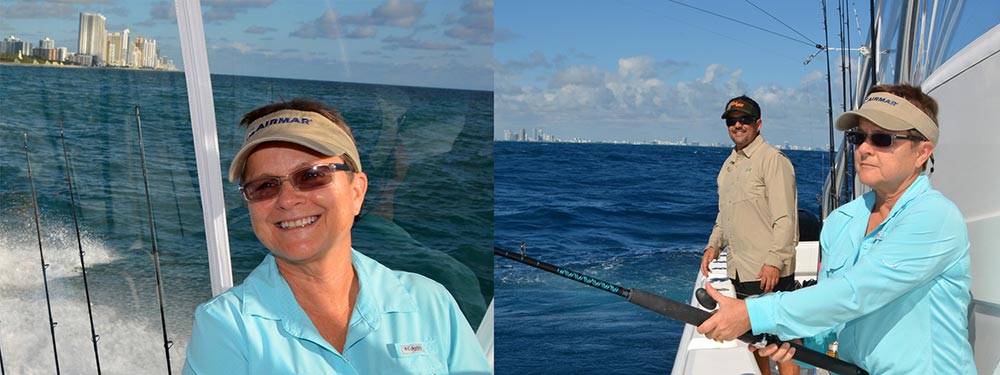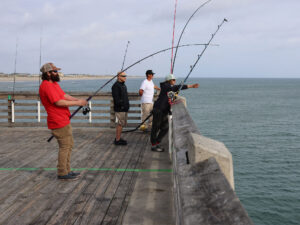
Transitions Vantage lenses
Offshore fishermen must watch baits carefully and look for the flash of a billfish 10 feet below the surface. Inshore anglers need to see subtle differences in bottom structure and pick up dartlike shapes against mottled backgrounds.
So the abilities to see clearly, to block glare and to dial up polarization and contrast are key to many successful saltwater fishing trips. That means anglers must prepare their eyes for this work with proper glasses.
For those of us with less than 20/20 vision, the choices have been:
- Wear contacts and polarized sunglasses.
- Wear polarized prescription sunglasses.
But now, there’s a third choice: Transitions Vantage lenses. Transitions — a company long known for its photochromic prescription glasses that darken with UV exposure — debuted Vantage in mid-2012. But the technology began making its way into fishing and boating markets late last year.
Vantage lenses not only darken with UV exposure, they polarize. I heard about Vantage lenses last September, and have since sampled a pair while offshore and inshore fishing. I also included them in our February issue New Products column.
I was skeptical at first — that’s my nature — but the glasses have certainly proven to be a viable alternative to contacts and prescription sunglasses.
FIRST IMPRESSIONS
Like many people with astigmatism, I see much better with prescription glasses than with contacts. So the clarity and crispness I get with Vantage satisfies my first priority. Not only can I see detail at a distance, but also up close. (I have a progressive-lens prescription.)
The Vantage lenses also darken as UV exposure increases. So in brightest sunlight, they — like most sunglasses — block 85 to 95 percent of visible light. The polarization reacts similarly.
I first wore the Vantage lenses on a sailfishing trip off Miami in December. I brought along a pair of prescription sunglasses for comparison. The day was sunny and fairly warm, but in December, even the daylight over Florida dims slightly due to a lower sun angle.
I saw the same color changes and easily picked up the baits with both. However, subjectively, I felt I saw with a little better clarity using the Vantage lenses — which didn’t quite shut out as much light as my mirrored sunglasses.
The dark, mirrored sunglasses might have blocked a little more glare — hard to tell — but they also blocked more visible light. There’s always a balance when selecting what works best in which conditions. That is an advantage to Vantage: They darken according to conditions.
My eyes also felt comfortable and relaxed throughout the day. I experienced no eyestrain, nor did I squint.
ADDITIONAL TESTING
On a sunny day in coastal Georgia, where I live, I tried Vantage in a shallow-water fishing situation. Granted our water here ranges from green and gritty to brown and muddy, but the polarization did allow me to see subtle water-color changes where oyster reefs meet mud.
I’d love to try these glasses during a true sight-fishing excursion, but I’ll have to wait until April when our tripletail arrive and feed at the surface along our coast. I’d also like to try them in low-light conditions, and on high-overhead-sun days.
I have also worn the Vantage glasses for ordinary land-based activities. I have come to some conclusions and have a few tips about how and when these should best be used.
First, when I chose the frames for these lenses, I tried to find the largest pair I could that didn’t make me look bug-eyed. Coverage is very important when glare is coming in from all sides — bouncing off the water like heated atoms in a science project.
I also requested an anti-reflective coating for the backside of these lenses. For more on that, see question No. 7 in the Q&A.
Once I got the glasses, I found them very comfortable and really liked that I could walk outside and enjoy the quick photochromic change, then walk back inside and work at my computer. I also drive my car with the sunroof open most days, which activates the photochromic dyes enough for the glasses to darken in my vehicle.
In general, I liked the fact that I could use the same product indoors or outdoors without worrying about inserting or removing contacts or switching glasses. On days when I’m rushed or just need an easy solution, these glasses shine.
Then, to better understand how Transitions developed this technology, I asked a series of questions to Transitions senior scientist Anil Kumar. This definitely helped me grasp just why and how Vantage works.
Q&A
1. ME: Explain the basics of photochromic lenses and how Transitions can add polarization into the equation — since that has never been achieved before?
KUMAR: Photochromic lenses contain trillions of dye molecules, which upon exposure to UV light (present in sunlight) change to different structure that absorb visible light. This reaction and absorption of visible light is what causes the lens to darken. This reaction is also reversible, which means when the lens is not exposed to sunlight, the molecules reverse back to their original structure and the lens becomes clear.
Conventional photochromic molecules darken in a random pattern and equally absorb all planes of visible light. Transitions has developed a very unique and revolutionary technology by creating a lens in which dye molecules not only darken under the influence of UV light but also align into a proper angle in the lens so they can selectively absorb the horizontal plane of the visible light and become polarized.
NOTES: In followup conversation, Kumar told me that Transitions uses two methods diffusion (after heating) and transponding (a coating) so that the lens accepts the dye molecules. The method employed depends on the material used in the lens.
2. ME: What percentage of visible light can Transitions photochromic lenses block from reaching the eye?
KUMAR: In typical sunny-day conditions, all Transitions everyday lenses block 100 percent of UVA and UVB and block visible light as ordinary sunglasses.**** Transitions lenses are responsive, adaptive lenses, and they adapt their darkness depending on outdoor conditions. The level of darkness depends on the amount of UV light present, temperature, time of day and direction of the sun.
NOTES: I posed a question about the difference between various color lenses and mirroring in sunglasses and how that affects light transmission — and then how that compared to Vantage, which only comes in a gray color now. Kumar said that in the right conditions, Vantage can block more than 90 percent of visible light. In a very general scenario, on average, they block 88 percent. Most sunglass companies say their lenses block 82 to 92 percent. So Vantage is in the same ballpark.
3. ME: What level of polarization can Vantage achieve?
KUMAR: Transitions Vantage lenses provide polarization by selective absorption of one plane of visible light in its darkened state. The level of polarization is related to the darkness of the lens, so the darker the lens gets, the higher the level of polarization or polarization efficiency. Like the darkness, the level of polarization also depends on the amount of UV light present, temperature, time of day and direction of the sun.
NOTES:**** I posed a question about what percent polarization the technology can achieve. Kumar told me that most sunglasses offer about 98 to 99 percent polarization; Vantage is in the 90s, depending on conditions.
4. ME: How does polarization increase or decrease with UV exposure?
KUMAR: When the lens is exposed to UV light, in its initial stage, only a small number of dye molecules turn dark and align. This small number of molecules provides a small amount of darkness and polarization. As the exposure of UV light continues, more dye molecules turn dark and start to accumulate darkness and increase the level of polarization. Both the darkness and polarization of Transitions Vantage lenses varies hand-in-hand and is interdependent. This variable polarization with varying darkness is unique and clearly breaks the paradigm of conventional polarization.
5. ME: Is this technology available in glass and polycarbonate lens materials?
KUMAR: Transitions Vantage lenses are only available in plastic-lens substrates, including polycarbonate. (On the phone, Kumar added that there are six or seven kinds of plastics that can be used. Polycarbonate and Trivex have the best impact resistance.)
6. ME: Since a dye, rather than a film, creates the polarization, how long does that dye last and will it fade over time?
KUMAR: The dyes used in Transitions lenses are designed to last the lifetime of the wearer’s vision-care prescription. (On the phone, Kumar added that every dye eventually fades. “Organic things don’t last forever. The average prescription life is about two years. The fading is then very gradual; you won’t even notice it.”)
7. ME: How does Transitions battle the “glare factor,” which is highly prevalent on the water?
KUMAR: Transitions has developed very unique photochromic dyes that when they darken, they align into a pattern of a horizontal line, which selectively absorbs the polarized light from the horizontal plane. (On the phone, we discussed adding antireflective coatings to the backside of the lenses to reduce reflection coming from light sources behind the wearer. That light bounces off the backside of the lens and into the eyes. This antireflective coating is something anglers should definitely request as an additional lens treatment.)
8. ME: One aspect of these lenses that anglers will really want to know: Will it ever be possible to use different lens colors in Transitions Vantage? For instance, amber/copper lens colors help improve the contrast for inshore anglers trying to see fish swimming over a shallow, grassy bottom or in tannin-stained waters.
KUMAR: Transitions Vantage lenses are produced using the Trans-Polarizing process, a new state-of-the-art process. This process is suitable for producing lenses of varying materials, colors, shapes, diameter and designs. The answer to your question is yes, it is possible to produce other colors. (On the phone, Kumar clarified that the decision to produce other colors of Vantage lenses is a corporate one, and there is no plan right now to do that.)
Adding Vantage and anti-reflective coatings to your lenses obviously increases the cost of your glasses, but the amount varies based on the specific prescription. In addition, not all labs can process a Vantage prescription. Talk to your optometrist and visit the Transitions website for more








